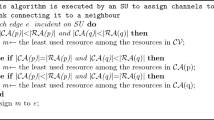Abstract
In online social network, many data are created by human activities. Data communication in social networks can be recorded and analyzed by evaluation. The identification of nodes with the same types of attribute among numerous users has become a research problem in the field of social opportunistic network. Many mobile devices by users have to save and deliver information moment by moment. However, cache space with devices in social network is limited; a large amount of data must be saved and transmitted on time in online social networks. Delay and low delivery ratio may affect communication in opportunistic network. Thus, we propose an algorithm based on user nodes and neighbors in opportunistic networks to improve the transmission environment. Such networks can identify surrounding neighbors to evaluate nodes with probability, which will evaluate neighbors, ensure the high probability of node preferential access to information, and achieve the objectives of cache adjustment. Cache by node can be distributed reasonably. Experiments and a comparison of social opportunistic network algorithms show that the proposed method improves the cache utilization rate of nodes, reduces data transmission delay, and improves the overall network efficiency.








Similar content being viewed by others
References
Hu Y, Liu A (2015) An efficient heuristic subtraction deployment strategy to guarantee quality of event detection for WSNs. Comput J 58(8):1747
Wang G, Wang B, Gao Y (2010) Dynamic spray and wait routing algorithm with quality of node in delay tolerant network. In: International Conference on Communications and Mobile Computing. IEEE, pp 452–456
Wu J, Chen Z (2018) Sensor communication area and node extend routing algorithm in opportunistic networks. Peer-to-Peer Netw Appl 11(1):90–100. https://doi.org/10.1007/s12083-016-0526-4
Wu J, Chen Z, Zhao M (2017) Effective information transmission based on socialization nodes in opportunistic networks. Comput Netw 129(1):297–305. https://doi.org/10.1016/j.comnet.2017.10.005
Aliotta JM, Pereira M, Johnson KW et al (2012) Microvesicle entry into marrow cells mediates tissue-specific changes in mRNA by direct delivery of mRNA and induction of transcription. Exp Hematol 38(3):233–245
Lokhov AY, Mézard M, Ohta H et al (2014) Inferring the origin of an epidemic with a dynamic message-passing algorithm. Phys Rev E 90(1):012801
Korkmaz T, Krunz M (2015) A randomized algorithm for finding a path subject to multiple QoS requirements. Comput Netw 36(2):251–268
Misra S, Ojha T, Mondal A (2015) Game-theoretic topology control for opportunistic localization in sparse underwater sensor networks. IEEE Trans Mob Comput 14:990–1003
Wu J, Chen Z, Zhao M (2018) Weight distribution and community reconstitution based on communities communications in social opportunistic networks. Peer-to-Peer Netw Appl. https://doi.org/10.1007/s12083-018-0649-x
Onus M, Richa AW (2016) Parameterized maximum and average degree approximation in topic-based publish-subscribe overlay network design. Comput Netw 94(C):307–317
Chen K, Shen H (2017) FaceChange: attaining neighbor node anonymity in mobile opportunistic social networks with fine-grained control. IEEE/ACM Trans Netw 25(2):1176–1189
Zheng H, Wu J (2017) Up-and-down routing through nested core-periphery hierarchy in mobile opportunistic social networks. IEEE Trans Veh Technol 66(5):4300–4314
Wu J, Chen Z, Zhao M (2018) Information cache management and data transmission algorithm in opportunistic social networks. Wirel Netw. https://doi.org/10.1007/s11276-018-1691-6
Wu J, Chen Z, Zhao M (2018) Information transmission probability and cache management method in opportunistic networks. Wirel Commun Mob Comput 2018, Article ID 1571974, p 14. https://doi.org/10.1155/2018/1571974
Wang Y, Wu J, Xiao M (2014) Hierarchical cooperative caching in mobile opportunistic social networks. In: 2014 IEEE Global Communications Conference, Austin, TX, pp 411–416
Saha BK, Misra S, Pal S (2017) SeeR: simulated annealing-based routing in opportunistic mobile networks. IEEE Trans Mob Comput 16(10):2876–2888
Burns B, Brock O, Levine BN (2017) MORA routing and capacity building in disruption-tolerant networks. Ad Hoc Netw 6(4):600–620
Saha BK, Misra S (2016) Named content searching in opportunistic mobile networks. IEEE Commun Lett 20(10):2067–2070
Gao W, Cao G, Iyengar A, Srivatsa M (2014) Cooperative caching for efficient data access in disruption tolerant networks. IEEE Trans Mob Comput 13(3):611–625
Wang J, Cao J, Ji S, Park JH (2017) Energy efficient cluster-based dynamic routes adjustment approach for wireless sensor networks with mobile sinks. J Supercomput 73(7):3277–3290
Wang J, Ju C, Kim H, Sherratt RS, Lee S (2017) A mobile assist coverage hole patching scheme based on particle swarm optimization for WSNs. Clust Comput. https://doi.org/10.1007/s10586-017-1586-9
Wang J, Cao J, Sherratt RS, Park JH (2017) An improved ant colony optimization based approach with mobile sink for wireless sensor networks. J Supercomput. https://doi.org/10.1007/s11227-017-2115-6
Convolbo MW, Chou J (2016) Cost-aware DAG scheduling algorithms for minimizing execution cost on cloud resources. J Supercomput 72(3):985–1012
Rodríguez-Mazahua L, Sánchez-Cervantes JL, Cervantes J et al (2016) A general perspective of Big Data: applications, tools, challenges and trends. J Supercomput 72(8):1–41
Huh JH, Otgonchimeg S, Seo K (2016) Advanced metering infrastructure design and test bed experiment using intelligent agents: focusing on the PLC network base technology for Smart Grid system. J Supercomput 72(5):1–16
Lin KC, Zhang KY, Huang YH et al (2016) Feature selection based on an improved cat swarm optimization algorithm for big data classification. J Supercomput 72(8):1–12
Lee B, Lee JH (2016) Blockchain-based secure firmware update for embedded devices in an Internet of Things environment. J Supercomput 73(3):1–16
Irshad A, Chaudhry SA (2016) Comments on “A privacy preserving three-factor authentication protocol for e-health clouds”. J Supercomput 73:1–5
Keränen A, Ott J, Kärkkäinen T (2009) The ONE simulator for DTN protocol evaluation. In: International Conference on Simulation TOOLS and Techniques. ICST (Institute for Computer Sciences, Social-Informatics and Telecommunications Engineering), p 55
Funding
This work was supported in The National Natural Science Foundation of China (61672540); Hunan Provincial Natural Science Foundation of China (2018JJ3299, 2018JJ3682); China Postdoctoral Science Foundation funded project (2017M612586); Foundation of Central South University (185684); Major Program of National Natural Science Foundation of China (71633006).
Author information
Authors and Affiliations
Corresponding author
Rights and permissions
About this article
Cite this article
Wu, J., Chen, Z. & Zhao, M. SECM: status estimation and cache management algorithm in opportunistic networks. J Supercomput 75, 2629–2647 (2019). https://doi.org/10.1007/s11227-018-2675-0
Published:
Issue Date:
DOI: https://doi.org/10.1007/s11227-018-2675-0




